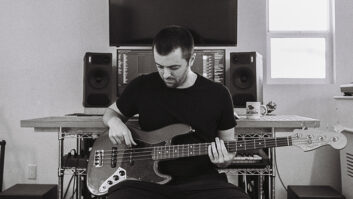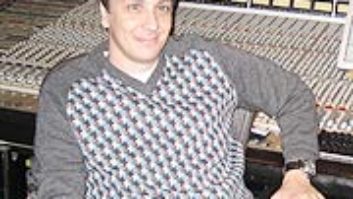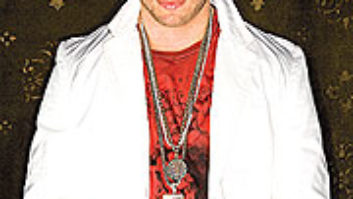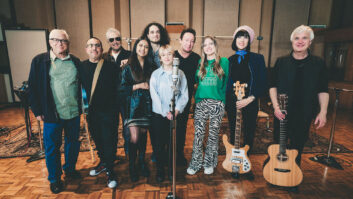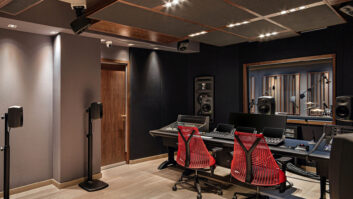NEW YORK, NY—In the candlelit tracking room at a studio on the Lower East Side, country/rockabilly legend Greg Garing performs in front of a small audience of invited guests. Garing is positively spellbinding, the songs he delivers barely contained within the form, vocals and acoustic guitar blazing, from a whisper to a scream and back again.
Occasionally, he is joined by one or two vocal accompanists, or takes to an upright piano in a fashion that would make Jerry Lee proud, or even worried. It’s a rare kind of performance, and rarer still in the age of unlimited tracks, choices and plug-ins.
L.E.S. Records founder Todd Perlmutter at the Rupert
Neve Designs 5088 console in the control room at
Loho Studios On this night, Garing is the personification of the new label that releases his eponymous album this month. L.E.S. Records, based in the neighborhood for which it is named—the Lower East Side—brings to mind the independent labels launched decades ago by passionate music enthusiasts.

L.E.S. Records was conceived by Todd Perlmutter, who is also the creative director for music and sound for the Blue Man Group. After recording for several years on nearby East Third Street, the wildly successful Blue Man Group purchased Loho Studios and now records its audio content there. L.E.S. Records is also based at Loho.
L.E.S. Records may fit the “throwback” description for its resolute reliance on analog recording equipment, including an Otari MTR 90 III multitrack tape machine and MCI, Otari and Ampex 2-track machines— mixdowns requiring multiple machines due to their advanced age. But, as Perlmutter explains, the sonic characteristics of his equipment choices are only one part of the story.
“There are audio ramifications towards recording full analog, but that really wasn’t the main goal,” he states. “The main goal was to record in the way where you were forced to grab the performances. The main thing I feel is missing is the concept that you’re capturing a performance that someone is doing, on anything—vocal especially, but guitar, a drum track, anything. It seems the way budgets are, it’s like, ‘Do it quick; we’ll clean it up in the computer later.’ As soon as you start down that ‘cleaning’ path, it’s a slippery slope: You’re grabbing bits and pieces of different performances and gluing them together. To me, that vibe that I find exciting is gone. Now that that’s so much harder to find, I just want to get more of it.”
This month, L.E.S. Records also releases an eponymous album by the Lingering Doubts—fronted by guitarist/ vocalist Christian Dyas and featuring Perlmutter on drums—that reinforces the L.E.S. manifesto. The track “Auto-Tune Is a Disease,” for example, pointedly questions the present-day culture of “perfection” and a music industry dominated by American Idol.
“For both of these records,” says Perlmutter, “there’s somewhat of a core band that has played together a little, but really, these were done in that old-school way. Every single vocal take on Greg’s record was his first. There’s one song [on which] he tracked vocals, sax and drums. There was no guitar or piano or bass to lay the arrangement down. We put organ on it later, and the arrangement is just crazy, but we had to keep this magical vocal performance. Chris, as well, would come into the studio, play the song for the band, and say, ‘Let’s do it.’ There’s a sizzle of excitement for them being so new to everyone.”
That said, Loho’s equipment list seems tailored for the L.E.S. philosophy. The control room features a Rupert Neve Designs 5088 customized with 32 additional classic Neve mic pres: sixteen 1064 and 16 1081 pres taken from the previous console housed at Loho. “We call the console the Time Traveler,” says Perlmutter, “because if you want to go through 1973, you hit that button and it goes through [the vintage pres]. We got this [5088] in 2010, so it’s the new, and it’s clean and really happening.”
What’s more, he adds, “the mixes had no automation, so they were all hands-on-faders mixes from tape— three guys with their fingers on the console. Mixing like that has some vibe, too—I feel like that adds some excitement that gets lost [in automated consoles].”
Microphones used to capture these performances include a pair of RCA 77s, a Neumann U 67 and U 87, and a U47 by Telefunken USA. “It’s a really fantastic mic,” Perlmutter reports. “The Neumann 47 is really happening, but for vocals I’ve used the Telefunken a little more.” Reverbs and delays were also accomplished the old-fashioned way. “The plate sounds great. It’s noisy. Forget the tape: The thing that makes more noise than anything else is that plate. But it sounds so good, and it’s on everything on both records.”
With its first two releases hitting retailers and e-tailers this month, Perlmutter is looking forward to recording a second release with each artist, and may then seek additional talent for L.E.S. Records. “It’s a pretty hardcore, old-school, relic-type recording situation,” he summarizes. And it was fun to do.”
L.E.S. Records
lesrecs.com
